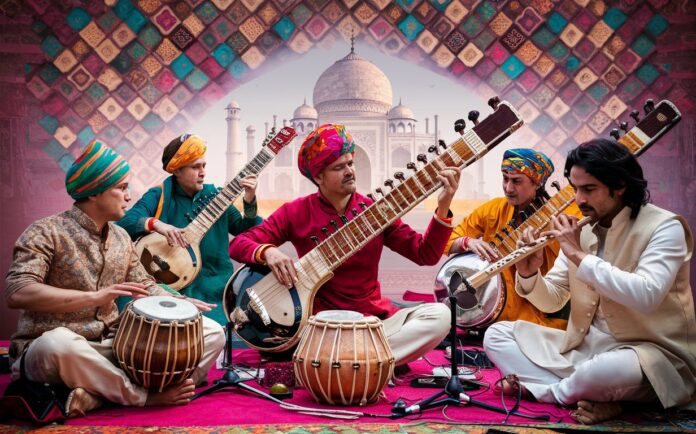History of Music of India
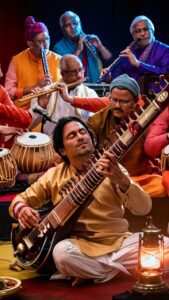
The history of traditional music in India is complex, stretching back thousands of years. Traditional music in India is incredibly diverse, reflecting the country’s rich cultural heritage and the varied regional influences across its vast expanse. It diverged from Carnatic music around the 13th–14th centuries CE, primarily due to Islamic influences.
India’s musical heritage traces its roots to ancient times, with references to music found in the Vedas, the oldest scriptures of Hinduism. Indian classical music has two foundational elements, raga and tala. The Samaveda, one of the four Vedas, is particularly significant as it contains hymns meant to be sung during religious rituals and this period laid the foundation for classical music with the concept of ragas and talas.
During the medieval period, This era saw the emergence of several classical music traditions, such as Hindustani and Carnatic music.
The Mughal period (16th to 18th centuries) they played a crucial role in the development of Indian music. The Mughal emperors were patrons of the arts, and they contributed to the synthesis of Persian and Indian musical traditions. This fusion led to the creation of new musical forms and styles, including the development of the sitar and the tabla.
The 20th century witnessed the revitalization and preservation of traditional Indian music, thanks to efforts by musicians, scholars, and institutions. Prominent musicians like Ravi Shankar and Vilayat Khan helped popularize Indian classical music worldwide, while organizations like All India Radio and Sangeet Natak Akademi played key roles in its promotion and preservation.
Overview Music of India
| Popular Traditional Music of India |
|---|
| Hindustani classical music |
| Ghazal |
| Dandiya |
| Rajasthani Music |
| Qawwali |
| Uttarakhandi Music |
| Carnatic Music |
| Bengali Folk Music |
| Light Music |
| Hori |
| Classical Dance Music |
| Bollywood Dance Music |
| Devotional Dance Music |
| Indian Regional Music |
Hindustani classical Music
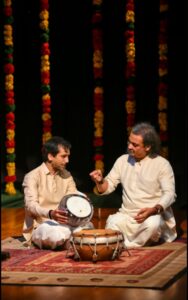

Hindustani classical music is a traditional form of Indian music known for its intricate melodies, rhythmic patterns, and emotional expression. Hindustani classical music is a traditional form of Indian classical music that originated in the northern regions of the Indian subcontinent. Rooted in ancient traditions and steeped in cultural significance, Hindustani classical music is much more than just a form of entertainment; it is a deeply spiritual and enriching experience that transcends time and space.
At its core, Hindustani classical music revolves around two fundamental elements: ragas and talas. Ragas are melodic frameworks that serve as the foundation for musical compositions, each evoking a specific mood or emotion. Talas, on the other hand, are rhythmic cycles that provide a structured framework for performances. Together, ragas and talas form the backbone of Hindustani classical music, guiding musicians through intricate improvisations and emotive expressions.
Unlike Western classical music, which often relies on written scores, Hindustani classical music encourages performers to spontaneously create and develop melodic and rhythmic motifs within the framework of a raga and tala.
Hindustani classical music is like a magical journey through sound, deeply rooted in the traditions of northern India. It’s all about creating beautiful melodies and rhythms that touch the heart and soul. There are two main ways Hindustani classical music is performed: vocal and instrumental. Vocal music, called “gayaki,” is all about using the voice to express emotions and feelings.
Learning Hindustani classical music is a bit like joining a special club. Students learn from a teacher, called a guru, who passes down their knowledge and wisdom from generation to generation. It’s not just about learning how to play an instrument or sing – it’s also about understanding the deeper meaning behind the music and connecting with the traditions of the past.
Hindustani classical music isn’t just something you listen to – it’s an experience that can take you on a journey of the mind and soul. Whether you’re listening to a performance in a concert hall or a small gathering, the music has a special way of touching your heart and making you feel connected to something bigger than yourself. It’s a beautiful part of Indian culture that has been cherished for centuries, and it continues to inspire and uplift people all over the world.
Ghazal
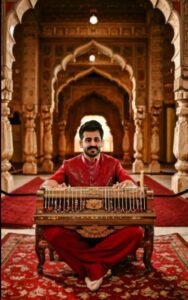

Ghazal is like musical poetry that touches the heart with its beauty and emotions. It’s a traditional form of music that originated in Persia and became popular in countries like India, Pakistan, and Afghanistan. . Each ghazal is like a little story or poem, expressing deep emotions like love, longing, and heartbreak. The lyrics are usually written in Urdu or Persian, and they often talk about themes like romance, nature, and spirituality.
When you listen to a ghazal, you’ll hear a singer singing the lyrics with a lot of emotion and feeling. They might be accompanied by instruments like the tabla, harmonium, and sometimes the sitar or flute. The music is usually slow and melodic, allowing the singer to express the emotions of the lyrics. It’s not about flashy performances or big concerts – it’s about creating a personal connection between the singer and the listener.
One of the most famous ghazal singers was Jagjit Singh, who popularized the genre in the 20th century with his soulful voice and heartfelt renditions. He brought ghazal to a wider audience and introduced new generations to its beauty and depth.
Learning to sing or appreciate ghazal takes time and practice, but it’s worth it for the emotional journey it can take you on. Whether you’re feeling happy, sad, or somewhere in between, there’s a ghazal out there that can speak to your heart and soul. Ghazal is more than just music – it’s a form of art that has the power to heal, inspire, and uplift. It’s a beautiful part of South Asian culture that continues to be cherished and celebrated to this day.
Dandiya
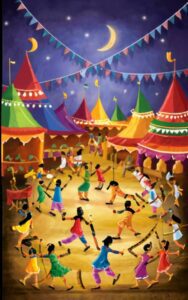

Dandiya is a lively and colorful folk dance that originated in the Indian state of Gujarat. It’s often performed during the festival of Navratri, which celebrates the triumph of good over evil and the victory of the goddess Durga over the demon Mahishasura.
The word “dandiya” comes from the term “dand,” which means stick. In this dance, participants use small, decorated sticks called “dandiya” as props while dancing. The dance is performed in pairs, with dancers moving in circles and striking their partner’s sticks in a rhythmic pattern.
Dandiya is not just about dancing – it’s also a social gathering where people come together to celebrate and have fun. The dance is accompanied by lively music played on traditional instruments like the dhol (drum) and the melodious sounds of the flute and harmonium.
‘Dandiya’ or ‘Dandiya Raas’ is a dance form performed during the time of Navratri, with its origins in Gujarat. The dance attire comprises bamboo sticks painted in bright colors, women are dressed in three-piece attires called Chaniya choli.
Dandiya is not just a dance – it’s a celebration of culture, community, and tradition. It brings people together from all walks of life to share in the joy and camaraderie of the festival season. Whether you’re a seasoned dancer or just looking to have a good time, dandiya is sure to lift your spirits and leave you with memories to cherish for years to come.
Dandiya is not just a dance – it’s a celebration of culture, community, and tradition. It brings people together from all walks of life to share in the joy and camaraderie of the festival season. Whether you’re a seasoned dancer or just looking to have a good time, dandiya is sure to lift your spirits and leave you with memories to cherish for years to come.
Rajasthani Music


Rajasthani music is like a colorful tapestry woven with the vibrant threads of Rajasthan’s rich culture and heritage. It’s a unique and enchanting form of folk music that reflects the desert landscapes, royal history, and colorful traditions of this majestic Indian state.
One of the most popular forms of Rajasthani music is folk songs, which are sung by locals to celebrate various occasions and festivals. These songs are often accompanied by energetic dances, with performers clad in vibrant attire and adorned with elaborate jewelry, creating a spectacle of color and movement.
Another hallmark of Rajasthani music is the ballads and narrative songs that recount the tales of valor, love, and heroism of Rajasthan’s legendary warriors and rulers. These songs are passed down orally from generation to generation, preserving the rich history and folklore of the region.
Qawwali
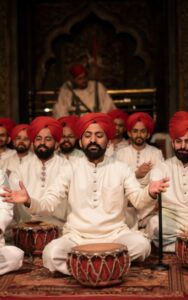

Qawwali music is like a beautiful journey through the heart and soul of South Asia. Asia many years ago. It is special because it is not just about singing; it is about expressing deep emotions and devotion to God and Sufi saints.
Qawwali is a type of music that comes from the Sufi tradition, a mystical branch of Islam. It is performed by a group of singers and musicians called qawwals. They sing in a way that is both powerful and soothing, using their voices to convey deep emotions. Qawwali music is usually accompanied by a variety of instruments. The harmonium, a small keyboard instrument, provides the melody, while the tabla, a pair of drums, sets the rhythm. Other instruments like the dholak, sarangi, and sitar may also be used to add depth and richness to the music.
The lyrics of qawwali songs are often based on poetry written by Sufi saints. These poems are filled with beautiful words that express love, longing, and devotion. Qawwali performances are usually held in places called mehfils, where people gather to listen to music. The qawwals sit in a circle, with the lead singer at the center.
Listening to qawwali music is a unique experience. qawwali music is a treasure of the Sufi tradition, offering a glimpse into the rich cultural heritage of South Asia. Its timeless melodies and profound lyrics speak to the deepest parts of our being, reminding us of the beauty and mystery of life.
Uttarakhandi Music


Uttarakhandi music, also known as Kumaoni and Garhwali music, is a beautiful expression of the culture and traditions of Uttarakhand. In the serene valleys of the Indian Himalayas lies a treasure trove of musical traditions known as Uttarakhandi music.
At the heart of Uttarakhandi music lies its folk traditions, which serve as a vibrant tapestry woven with threads of history, culture, and identity. The folk songs of the Kumaon and Garhwal regions encapsulate the essence of rural life, celebrating the joys and sorrows of the local communities. Whether it’s the soulful strains of a ‘Jhora’ sung during weddings or the lively tunes of ‘Jhumeila’ echoing across festive gatherings, folk music binds people together.
In Uttarakhand, music is not just entertainment; it’s a sacred ritual. During weddings, religious ceremonies, and festivals, melodious tunes fill the air, uniting communities in celebration. These ritualistic songs, with their soul-stirring melodies, evoke a sense of reverence and spirituality.
The musical heritage of Uttarakhand is also enriched by classical influences. Hindustani classical music has left its imprint on the region, inspiring musicians to explore new horizons while staying true to their roots. While rooted in tradition, Uttarakhandi music continues to evolve with the changing times. Modern artists are breathing new life into age-old melodies, blending traditional elements with contemporary sounds. This fusion of old and new has given rise to a vibrant music scene, appealing to audiences of all ages.
Uttarakhandi music is more than just a melody; it’s a cultural symphony that resonates with the hearts of the people. Through its folk tunes, ritualistic songs, classical influences, and modern interpretations, it weaves a tapestry of traditions, connecting past, present, and future. So let’s immerse ourselves in the enchanting world of Uttarakhandi music and let its melodies carry us away to the mystical realm of the Himalayas.
Carnatic Music


In the southern part of India, there’s a musical tradition that’s as old as the hills and as captivating as the waves of the ocean. It’s called Carnatic music. Let’s embark on a journey to explore the enchanting world of Carnatic music, understanding its essence, forms, and significance.
Carnatic music has a long and illustrious history that dates back thousands of years. Originating from the ancient scriptures and temple rituals of southern India, it has evolved, absorbing influences from various cultural and musical traditions. Carnatic music is a testament to the rich tapestry of Indian culture and spirituality.
At the heart of Carnatic music lie two fundamental elements: ragas and talas. Ragas are melodic frameworks that define the mood, structure, and ornamentation of a musical piece, while talas are rhythmic cycles that provide a framework for percussion accompaniment. Together, ragas and talas form the building blocks of Carnatic music, allowing musicians to explore a vast repertoire of compositions with creativity and expression.
Carnatic music is deeply rooted in the spiritual traditions of Hinduism, with many compositions dedicated to gods, goddesses, and spiritual themes. Whether it’s the soul-stirring bhajans of Saint Tyagaraja or the ecstatic kritis of Muthuswami Dikshitar, Carnatic music is infused with a sense of devotion and reverence that transcends the boundaries of language and culture. Through its melodies, Carnatic music seeks to evoke the bhakti rasa, or the essence of devotion, in the hearts of listeners.
Carnatic music is more than just a musical tradition; it’s a timeless art form that celebrates the beauty of melody, rhythm, and emotion. From its ancient origins to its modern manifestations, Carnatic music continues to inspire and enchant audiences around the world.
Bengali Folk Music
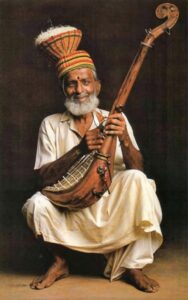

Bengali folk music reflects the cultural heritage and everyday lives of the people of Bengal. Let’s take a journey into this enchanting world to uncover its rhythms, melodies, and stories.
One of the most iconic forms of Bengali folk music is Baul music, sung by the wandering minstrels known as Bauls. Rooted in the mystical traditions of Bengal, Baul’s music combines elements of poetry, philosophy, and music to create a unique and soul-stirring experience. With simple melodies and profound lyrics, Baul’s songs explore themes of love, spirituality, and the search for divine truth, touching the hearts of listeners and inviting them on a journey of self-discovery.
Bengal’s rivers are not only a lifeline for the people but also a source of inspiration for its folk music. Bhatiali songs, sung by the boatmen of the rivers, capture the rhythms of life along the waterways. Another prominent form of Bengali folk music is Kirtan, a devotional singing tradition that traces its roots to the Bhakti movement. Led by a main singer (kirtaniya) and accompanied by musical instruments like the khol and Kartal, Kirtan sessions are characterized by call.
Humor is a vibrant folk dance form accompanied by lively music that celebrates the joys and sorrows of rural life. Originating from the tribal communities of Bengal, Jhumur songs and dances are performed during festivals, weddings, and other social occasions.
Bengali folk music is a reflection of the rich cultural heritage and vibrant traditions of Bengal. From the soulful melodies of Baul music to the rhythmic beats of Jhumur dances, Bengali folk music celebrates the beauty of life in all its diversity. As we immerse ourselves in the enchanting world of Bengali folk music, we discover not only the rhythms and melodies but also the stories and emotions that have shaped the lives of generations past and present.
Light Music


“Light music” is a broad term that refers to a style of music that’s easy to listen to and doesn’t require a lot of concentration. It’s the kind of music you might hear on the radio or in a café.
Light music usually features simple and catchy melodies that are easy to remember. These melodies tend to stick in your head and make you want to hum along. It’s designed to be enjoyable and easy on the ears, with melodies that stick in your head and lyrics that are easy to sing along with. Light music is great for lifting your mood and creating a pleasant atmosphere, whether you’re at home, in the car, or out with friends.
Some examples of light music include catchy pop songs by artists like Taylor Swift or Ed Sheeran, smooth jazz tunes by musicians like Kenny G, and gentle folk songs by artists like James Taylor or Norah Jones. These songs often have memorable melodies, simple chord progressions, and lyrics that are relatable and easy to understand. Overall, light music is all about making you feel good and brightening your day with its uplifting tunes and positive vibes.
Hori Folk Music
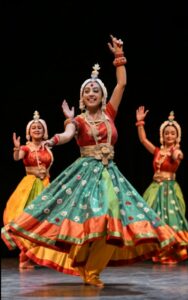

Hori is a vibrant and colorful form of folk music and dance that originated in the Braj region of North India, particularly in the states of Uttar Pradesh and Rajasthan. It is closely associated with the festival of Holi, also known as the Festival of Colors, which celebrates the arrival of spring and the victory of good over evil.
In Hori performances, singers and dancers come together to rejoice in the spirit of Holi, singing and dancing to traditional folk songs called “Hori.” These songs typically depict playful scenes of Lord Krishna and Radha, the divine lovers, and their companions, known as gopis, engaging in colorful and joyous festivities during Holi.
The music of Hori is characterized by lively rhythms and catchy melodies, often accompanied by traditional instruments such as the dholak (a double-headed drum), manjira (hand cymbals), and harmonium. The lyrics of Hori songs are filled with poetic imagery, the blossoming of flowers, and the playful antics of Krishna and Radha as they smear each other with colors and exchange love-filled glances.
Hori is not just a performance but a celebration of love, friendship, and the joy of life. It brings communities together, fostering a sense of unity and camaraderie as people sing, dance, and revel in the festive spirit of Holi. Through its vibrant music and exuberant dance, Hori captures the essence of this ancient festival, spreading happiness and harmony wherever it is performed.
Indian Dance Music


Indian dance music encompasses a wide variety of styles and genres that cater to the diverse cultural landscape of the country. From traditional folk dances to modern Bollywood beats, Indian dance music reflects the rich tapestry of India’s heritage and contemporary music scene.
Classical Dance Music: Indian classical dance forms such as Bharatanatyam, Kathak, Odissi, Kuchipudi, and Manipuri are accompanied by classical music that includes intricate rhythms, melodic patterns, and emotive expressions. Classical dance music is often based on classical ragas and talas, with live instrumentation featuring instruments like the tabla, sitar, flute, veena, and mridangam.
Bollywood Dance Music: Bollywood dance music is synonymous with Indian popular culture, featuring upbeat and catchy songs that accompany the colorful dance sequences in Indian films.
Devotional Dance Music: India is also home to a rich tradition of devotional music and dance forms such as Bhajan, Kirtan, and Sufi Qawwali. These spiritual dance forms are accompanied by soulful music that invokes a sense of devotion.
Indian Regional Music
India is the most artistic and popular country in the world. There are many arts and artists in this country who are famous all over the world. There are various regional and cultural arts here. Like music, dance, sports, etc. We are coming back to our topic “Traditional Music of India”. Different regions and cultures have different musical arts, the music is based on the regional language and culture.
List of Indian Regional Music
| Region | Music |
|---|---|
| Andhra Pradesh | Burra Katha, Oggu Katha, Harikatha, Jangam Katha and Lambadi |
| Arunachal Pradesh | Baryi- Baryi and Ja-Jin-Ja |
| Assam | Sohar |
| Bihar | Sohar, Sumangali, Ropnigeet sowing paddy and katnigeet |
| Chhattisgarh | Sohar Geet, Vivah Geet, Mrityu Geet, Bihav song and Sua Songs |
| Goa | Mando |
| Gujarat | Garba, Dandiya Raas, Padhar, Dangi and Tippani |
| Haryana | Haryanvi Lokgeet, Ragini and Haryanvi Folk Music |
| Himachal Pradesh | Samskara songs, Ainchaliyan and Pangi songs |
| Jharkhand | Jhumair, Dohari, Domkach, Janani, Jhumar, Jhumta, Mardana, Daidhara, Pahil sanjha, Adhratiya and VinsariaMusic |
| Karnataka | Carnatic classical music or Karnataka Sangeetha and Hindustani classical music |
| Kerala | Sopana Sangeetham and classical music |
| Madhya Pradesh | Haryanvi Lokgeet, Ragini, and Haryanvi Folk Music |
| Maharashtra | Lavani, Aagri – Koli Geet and Natya Sangeet |
| Manipur | Khullang Eshei, Lai Haraoba eshei and pena eshei |
| Meghalaya | Folk Traditional Music |
| Mizoram | Dar Hla, Puipun Hla and Lengzem Zai |
| Nagaland | Heliamleu and Hereileu songs |
| Odisha | Traditional Ritual Music |
| Punjab | Jugni, Mahia, Tappe, Jindua, Dhola, Kafian, Dohre, Bolian, Sadda, Jhokan and the folk |
| Rajasthan | Kalbelia of Rajasthan, Pankhida and Lotia |
| Sikkim | Tamang Selo and Dhamphu |
| Tamil Nadu | Carnatic music, Villu Pattu or Bow Song, Pannisai, and Ammanaivari |
| Telangana | Oggu Katha, Sarada Kala and savvy petals |
| Tripura | Folk Music and Indigenous Music |
| Uttar Pradesh | Rasiya Geet, Alha, Hori Kajr, and Sohar |
| Uttarakhand | Traditional and Contemporary songs |
| West Bengal | Bhatiali, Ragas, Shyama sangeet, Tappa and Brahma Sangeet |
Each regional music has its interpretation of festivals, culture, people, and special occasions. Music is played depending on the occasion. For example: Marriage functions, Festival occasions, relatives and culture etc.



